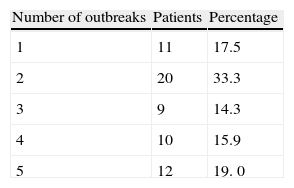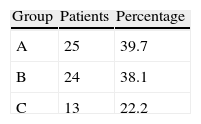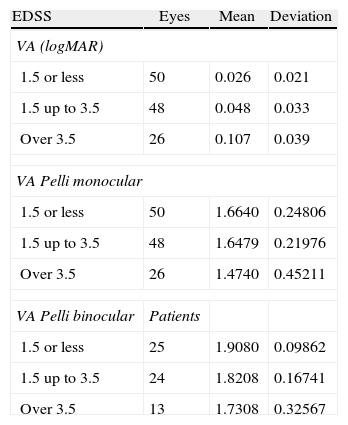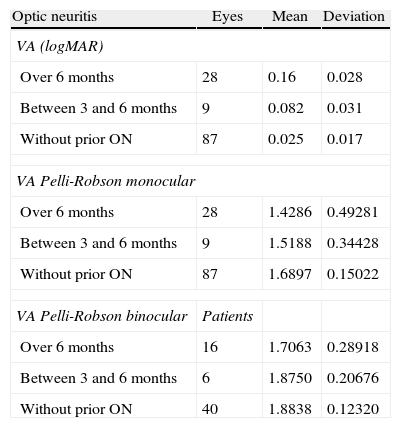To assess the importance of the Pelli-Robson contrast sensitivity test in multiple sclerosis patients according to the Expanded Disability Status Scale (EDSS).
Material and methodsA total of 62 patients with multiple sclerosis were included in a retrospective study. Patients were enrolled from the Neurology Department to Neuroophthalmology at Virgen de la Victoria Hospital. Patients were classified into three groups according to EDSS: group (A) lower than 1.5, group (B) between 1.5 and 3.5 and group (C) greater than 3.5. Visual acuity and monocular and binocular contrast sensitivity were performed with Snellen and Pelli-Robson tests respectively. Twelve disease-free control participants were also recruited. Correlations between parameter changes were analyzed.
ResultsThe mean duration of the disease was 81.54±35.32 months. Monocular and binocular Pelli-Robson mean values in the control group were 1.82±0.10 and 1.93±0.43 respectively, and 1.61±0.29 and 1.83±0.19 in multiple sclerosis patients. There were statistically significant differences in the monocular analysis for a level of significance p<0.05. Mean monocular and binocular Pelli-Robson values in relation to gravity level were, in group A: 1.66±0.24 and 1.90±0.98, group B: 1.64±0.21 and 1.82±0.16, and group C: 1.47±0.45 and 1.73±0.32 respectively. Group differences were statistically significant in both tests: p=0.05 and p=0.027.
ConclusionsMonocular and binocular contrast discrimination analyzed using the Pelli-Robson test was found to be significantly lower when the severity level, according EDSS, increases in multiple sclerosis patients.
Evaluar la utilidad de la prueba de sensibilidad al contraste Pelli-Robson en pacientes con esclerosis múltiple, dependiendo de la escala expandida del estado de discapacidad (EDSS).
Material y métodosEstudio retrospectivo de 62 pacientes diagnosticados de esclerosis múltiple y remitidos desde el Servicio de Neurología a la Unidad de Neurooftalmología del Hospital Virgen de la Victoria. Los pacientes fueron clasificados según la escala EDSS en 3 grupos: A) inferior a 1,5; B) entre 1,5 y 3,5 y C) superior a 3,5. Se determinó la agudeza visual y la sensibilidad al contraste monocular y binocular mediante las pruebas de Snellen y Pelli-Robson, respectivamente. Un total de 12 pacientes libres de enfermedad fueron reclutados como grupo control. Se analizaron estadísticamente los resultados obtenidos.
ResultadosEl tiempo medio de evolución de la enfermedad fue de 81,54±35,32 meses. Los valores medios del Pelli-Robson monocular y binocular en el grupo control fueron 1,82±0,10 y 1,93±0,43, mientras que en los pacientes con esclerosis múltiple fueron 1,61±0,29 y 1,83±0,19 respectivamente, siendo estas diferencias estadísticamente significativas en el análisis monocular para un nivel de significación de p<0,05. Respecto al nivel de gravedad, los valores medios monoculares y binoculares de la prueba de Pelli-Robson fueron en el grupo A: 1,66±0,24 y 1,90±0,98; en el grupo B: 1,64±0,21 y 1,82±0,16 y en el grupo C: 1,47±0,45 y 1,73±0,32, respectivamente. Las diferencias entre grupos mostraron una significación estadística para ambas pruebas: p=0,05 y p=0,027.
ConclusionesLa sensibilidad al contraste, monocular y binocular, analizada mediante la prueba de Pelli-Robson disminuye significativamente según aumenta el nivel de gravedad medida con la escala EDSS en pacientes con esclerosis múltiple.











